Let’s play a game: can you name the New Seven Wonders of the World, defined by the namesake campaign at the beginning of this millennium? If you answered Great Wall of China, Petra, Colosseum, Chichén Itzá, Machu Picchu, Taj Mahal, and Christ the Redeemer, well done! But what if we took it up a notch, and asked you about the original 7 wonders of the world?
Here’s an upgraded quiz question: Which among the following does not belong to the 7 ancient wonders of the world? Stonehenge, Borobudur, Angkor Wat, or the Leaning Tower of Pisa?
Hard? Well, it’s a trick question, as the correct answer is: none. With dozens of projects mimicking the original 7 Wonders of the Ancient World list, it’s easy to get confused.
Discover the original 7 Wonders of the World, with real map and artificial images!
Many circled: the Seven Wonders of the Medieval World, the Seven Wonders of the Industrial World, the Seven Natural Wonders of the World, the Seven Wonders of the Underwater World… It’s like everyone (including their grandma) wants to be part of the seven wonders club. If it doesn’t fit anywhere, well, just call it the eighth wonder of the world!
So it may sound convincing when someone’s talking about the seven world wonders and starts mentioning the Eiffel Tower, Statue of Liberty, Grand Canyon, Table Mountain, Banaue Rice Terraces, Ha Long Bay, or Niagara Falls.

While many exceptional natural and man-made sites had people’s jaws dropping for centuries, all of these lists springboarded from the initial one – the Seven Wonders of the Ancient World.
To set the records straight, we’re taking you back to where it all began. Our journey through time will transport us to an era when there were no Instagram influencers geotagging famous landmarks.
With the help of artificial intelligence and some good old-fashioned research, today we’re gonna reconstruct the original world of wonders!
According to the global poll organized between 2007 and 2011, one of the New 7 Wonders of Nature is Jeju Island in South Korea. Read on to discover its best attractions and things to do!
What are the wonders of the world?
Wonders of the world are exceptional structures, buildings or monuments, that demonstrate human ingenuity, innovation, and creativity. The meaning behind these extraordinary man-made marvels is that they are not just impressively captivating landmarks. They also represent symbols of civilizations’ achievements that showcase the diversity of cultures and eras that have shaped the identity of humanity.

How many wonders of the world are there?
Officially, there are seven wonders of the world. But just like with any list curated by people, it all depends on who’s counting. One person’s wonder might be another person’s meh.
There have been many attempts to expand the list of the original wonders of the world over the years. We’re talking 8 wonders, 10 wonders, 12 wonders, 20, 21, 25, 50, 100…
One cannot stop wondering if this Fibonacci-style counting could go ad infinitum, and before you ask: yes, some not-picky human minds did list 200 wonders of the world! And then they say that AI cannot count.
Why were there only 7 ancient wonders of the world?
Seven sounds more precious than 200.
As we know through history, the number seven was always regarded as a special number if not sacred. The magical properties of perfection were assigned to it (from the number of colors in a rainbow to the number of celestial bodies visible to the naked eye, each represented in the days of the week named after them).
It is believed Greeks were following the same grand idea of completeness when deciding on the most significant representatives of perfection on Earth – the amazing wonders of the world.
If you wonder about the capabilities of AI, we put it on the test. Find out how artificial intelligence predicted the travel trends in 2023!
Who decided the 7 Wonders of the Ancient World?
Essentially, the idea of the 7 Wonders of the Ancient World came from the travel bloggers of the time. Following the great conquests of Alexander the Great in the 4th century BC, the Hellenic travelers in the lands of Egypt, Persia, and Babylonia, wrote about theamata or sights. They were literally noting down “7 things to see” when the era of travel blogs that exploited the listicle writing format was not even on the horizon.
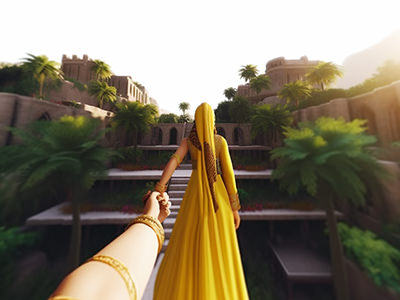
The world wonders appeared as a concept in the 2nd century BC. The Greek poet Antipater of Sidon created the first known 7 Wonders of the World list in 140 BC.
This is how he described them: “I have set eyes on the wall of lofty Babylon on which is a road for chariots, and the statue of Zeus by the Alpheus, and the hanging gardens, and the Colossus of the Sun, and the huge labor of the high pyramids, and the vast tomb of Mausolus; but when I saw the house of Artemis that mounted to the clouds, those other marvels lost their brilliancy, and I said, ‘Lo, apart from Olympus, the Sun never looked on aught so grand.’”
The idea spread among the travel writers of the time like a viral TikTok challenge. Some of the original influencers who mentioned the seven wonders were geographer Strabo, historian Diodorus Siculus, and paradoxographer Philo of Byzantium (‘De septem mundi miraculis’). Many writers referred to Herodotus as the original author of the World Wonders idea, but his list was never discovered.
Where are the 7 ancient wonders of the world located?
The old 7 wonders of the world were all located in the cultural space and landscape of the Mediterranean and the Near East. On today’s map, two of the wonders were on the territory of Greece, two in Turkey, two in Egypt, and one in Iraq.
Find all the locations on this original 7 Wonders of the World chart made by Pranav Gavali for Visual Capitalist.
When were the 7 Wonders of the Ancient World built?
The first of the 7 Wonders of the Ancient World to be built was the Great Pyramid of Giza. Egyptians erected their necropolis between 2584 and 2561 BC.
The remaining great wonders of the world were constructed between the 7th and 3rd centuries BC.
Fun fact: the only period in history when one could tick off all 7 wonders of the world from one’s bucket list lasted six decades in the 3rd century BC, during the lifespan of the Colossus of Rhodes.
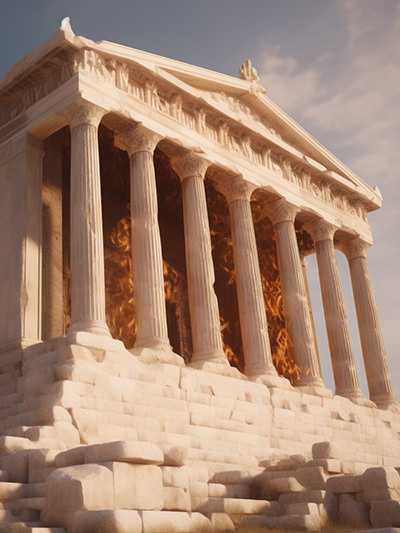
What happened to the Seven Wonders of the Ancient World?
Out of the 7 Wonders of the Ancient World, the only one still standing tall is the Giza Necropolis. After 4500 years, these impressive pyramids survived the test of time and became poster children of resistant architecture.
The other original 7 wonders sadly do not exist anymore. Most were destroyed by earthquakes, fire, floods, and conquerors. Some even with a combination of these. All that’s left of the wonders are archeological remains at best.
Besides the monuments to the civilization, even natural resources are going extinct. The future of chocolate is endangered after climate change radically reduced cocoa crop yields in West Africa. We've used the power of AI to create an alternate world of chocolate, including the sweetest version of the Giza pyramids. Check it out!
7 Wonders of the Ancient World list
So what are the 7 Wonders of the Ancient World? And what do we know about them? We reconstruct their story with the help of available real data and the imagination of Midjourney AI. These are the 7 Wonders of the Ancient World, in chronological order.
1. Great Pyramid of Giza
The first of the seven great wonders of the world to be built (in the 26th century BC), and the only one to endure till these days, is the Great Pyramid of Giza. It is also known as Khufu or Cheops Pyramid because it served as a tomb for this pharaoh and, according to Egyptian beliefs, his gateway to the afterlife.
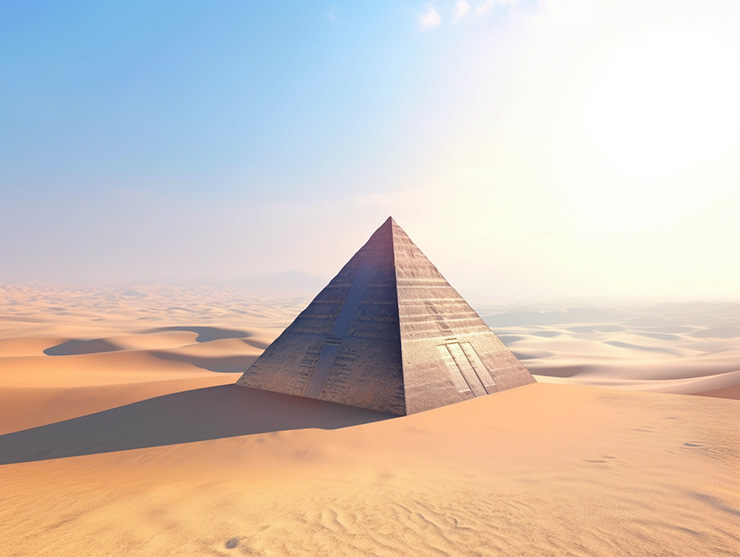
Located on the west bank of the Nile River, the Great Pyramid is the most colossal among the three pyramids in the group. It was supposedly built by Khufu’s nephew Hemiunu, a prince and architect in one. He designed the last surviving wonder of the ancient world, which used at least 2 million stone blocks, each weighing more than 2 tons.
The pyramid reaches a height of about 139 meters, but in its heyday, before time wore it out, the original height was closer to 147 meters. Its base is a square with sides 230 meters in length, which means you could fit about 42 Olympic-size swimming pools in there. Which they obviously didn’t do in the desert.
Before modern civilization started building cathedrals and skyscrapers, the spectacular Egyptian construction stood as the tallest man-made structure in the world for millennia. The architectural feat was so intriguing that it even inspired conspiracy theories that it was not built by slaves, but – by aliens.
If we move away from its supposed mystical and out-of-this-world properties, the Great Pyramid of Giza remains one of the most impressive engineering and architectural masterpieces in human history.
2. Hanging Gardens of Babylon
When we exclude the Great Pyramid of Giza, the valid question remains about the non-existing structures mentioned in classical antiquity write-ups: Did the Seven Wonders of the Ancient World really exist? After all, we do approach the Bible stories about, for instance, Noah‘s flood with a grain of salt, so could the world wonders be just mythological inventions?
Archeologists have dug up enough evidence to prove that the wonders on this original list were indeed real, with only the Hanging Gardens of Babylon still hanging in the air.
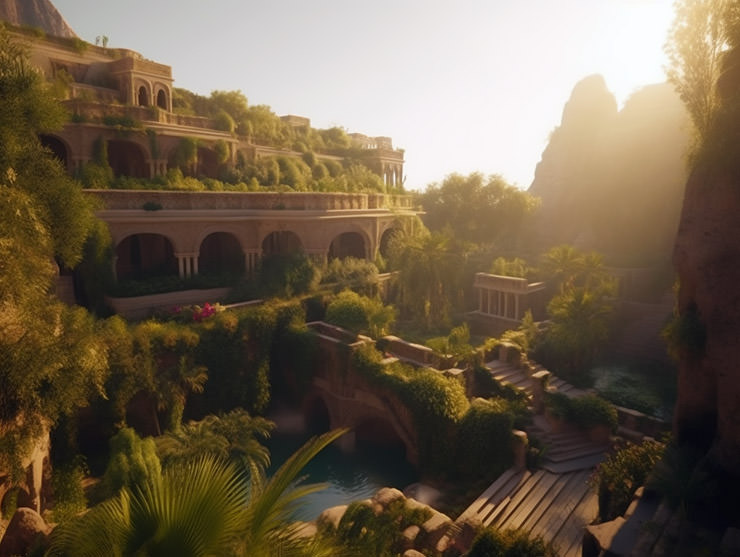
If they were real, it is believed they were built during the reign of Nebuchadnezzar II, the second king of the Neo-Babylonian Empire, in the 6th century BC, on the territory of Mesopotamia, in modern-day Iraq.
The king’s wife Amytis was from Media (today, northwestern Iran), and according to Diodorus Siculus, the king ordered the building of the Hanging Gardens of Babylon to tackle the queen’s homesickness.
To mimic the landscape of her homeland, the tiered botanical marvel supposedly resembled a mountain. Stairs led to a 23-meter-tall magnificent oasis populated with exotic trees and plants, bearing everything from flowers to fruits. The irrigation of the terraced gardens was automatic, through a series of waterfalls, powered by a system of pumps bringing water from the Euphrates River.
Some writers called this place the Hanging Gardens of Semiramis, after possibly also the mythical queen who supposedly ruled Babylon in the 9th century BC. Another theory says that these gardens were built by King Sennacherib in Nineveh, the capital of Assyria, in the 7th century BC.
We cannot say if the Hanging Gardens of Babylon belong to the history of facts or legends. There are no Babylonian sources to confirm Greek claims, and the quest for the lost wonder was made even harder due to a supposed earthquake. The devastating quake destroyed the lushest among the original 7 wonders of the world at the dawn of the new millennium.
3. Temple of Artemis at Ephesus
The Greek hunting goddess and Apollo‘s twin sister Artemis (the equivalent of Roman Diana) also got one of the old wonders of the world. The Temple of Artemis at Ephesus, the ancient Greek city whose location was determined by the Delphi Oracle, was erected in 550 BC.
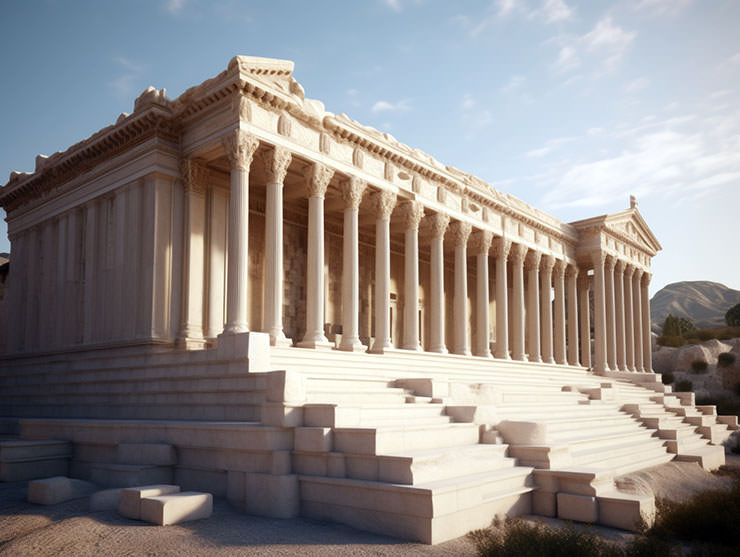
The architects from Crete, father Chersiphron and son Metagenes, built this gigantic temple out of marble. It was 115 meters long, 55 meters wide, and was supported by 127 Ionic-style columns, each over 18 meters tall.
It was an elevated place of worship, with the finest artworks of the time, displaying opulence in gold and silver. Because of its secure vaults, the sanctuary even served as a bank.
The Temple of Artemis at Ephesus today lies on the edge of the town of Selçuk, in Anatolia, Turkey. All that one can see of sometimes glorious Artemision are just fragments, with one lonely column reconstructed.
The temple was destroyed several times: in the 7th century BC by flood, in the 4th century BC by arson (a Greek pyromaniac Herostratus started the flame and achieved herostratic fame, the fame at any cost that was coined after him), and in 3rd century AD it was raided by Goths, and consequently erased by Christians.
Ephesus was recently the centerpiece of the Turkish tourism campaign, which Greeks didn't appreciate. Read about this and other controversial tourism promotions here!
4. Statue of Zeus at Olympia
The next to appear on the famous wonders of the world list was the Statue of Zeus at Olympia, the home of the Olympic Games in western Greece. In 435 BC, it was revealed in the Temple of Zeus, the temple so grand that it put all other worshipping places to shame. At the center of this sanctuary, stood the massive pièce de résistance, soon to be regarded as one of the most important artworks in Classical Greece.
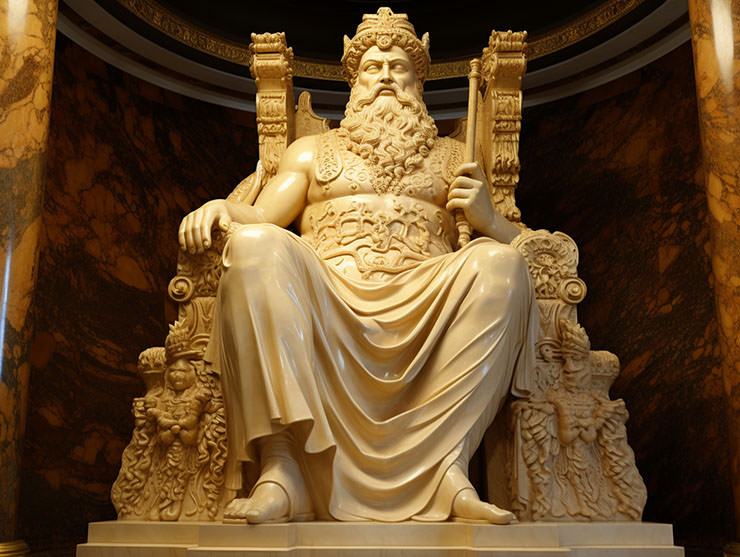
The renowned sculptor Phidias made the colossal representation of the king of gods in ivory, dressed to the nines in golden robes and precious gems. Zeus was sitting on a throne, and according to some sources, was holding a scepter with an eagle in his left hand, and a small statue of Nike, the goddess of victory, in his right hand. Yep, even the god of the sky needed a little reminder to “just do it”.
To make the lifelike statue always shine, but also to protect it from cracking, Greeks were constantly slathering it in olive oil. There was no skimping, only the best oil for the almighty god.
The Statue of Zeus at Olympia was 12,4 meters tall, and some even thought it was – too tall. So if Zeus had stood up from his throne (by some miracle), he would have knocked himself out on the sanctuary’s ceiling or brought the entire temple crashing down.
No such thing happened, as the combination of Christians, fire, earthquakes and flooding was disastrous enough to throw the fourth wonder of the ancient world to memory lane in the 5th century.
5. Mausoleum at Halicarnassus
One didn’t have to be a pharaoh to have his final resting place immortalized as one of the original seven wonders of the world.
The tomb of King Mausolus (and yes, this is where the word mausoleum comes from) is believed to be constructed in 350 BC. At the time, at the site of today’s Bodrum in Turkey, Halicarnassus was the capital of Caria, a small kingdom on the western coast of Asia Minor.
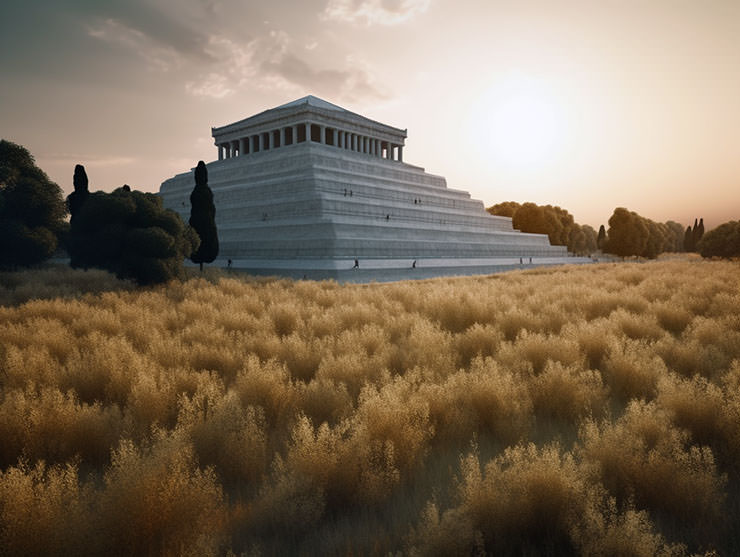
Nominally satrap in the Persian Empire, Mausolus was quite an independent ruler. He believed family jewels were best kept nearby, so he married his sister Artemisia II.
Besides spending enormous amounts of taxpayers’ money on beautifying the city with marble buildings and temples, the incestuous power couple decided to treat themselves to a fancy tomb on the hill overlooking their thriving kingdom.
Greek architects Satyros and Pythius of Priene designed a grandiose marble tomb that was about 45 meters tall and had 36 columns. The pyramid-shaped roof featured a statue of four horses pulling a chariot with the king and queen, while other intricate sculptures and ornate reliefs depicting scenes from Greek mythology adorned the building’s facade.
The Mausoleum’s reign as a wonder of the world was cut short by a series of earthquakes that shook the area between the 12th and 15th centuries. The monument of the original king and queen of sibling love, one of the most impressive structures of the ancient world, was thus lost to history.
6. Colossus of Rhodes
If you’ve ever heard of nude beaches in Greece, you’ll know that the country just adores sunshine. Rhodes, the island in the eastern Aegean Sea, is nicknamed the Island of Sun (and speaking of naturism, it even has its clothing-optional hotel), so it was only natural they would spotlight their patron saint in the form of a titanic statue.
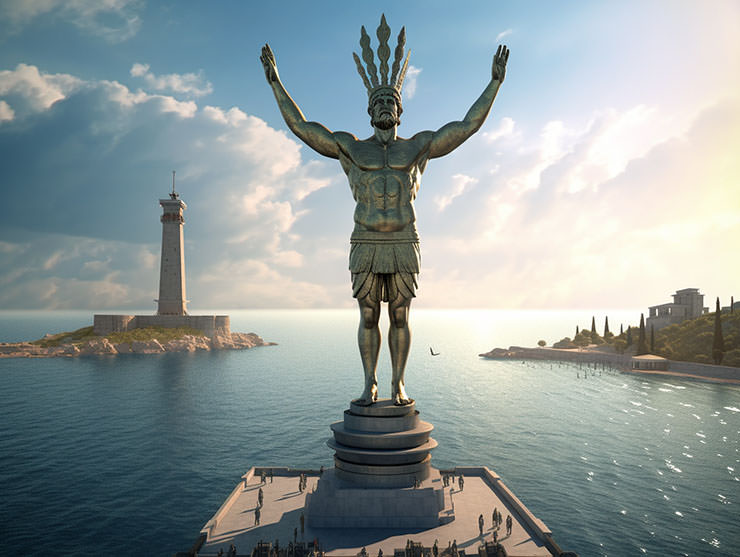
The local sculptor Chares of Lindos constructed the Colossus of Rhodes between 292 and 280 BC. The massive monument representing Helios, the god of the sun, was greeting incoming ships to the harbor, like a Greek version of the Statue of Liberty. It was reaching a back-then whopping height of 33 meters, like a giant beacon of power and wealth.
The bronze monument was made of the melted weapons from the island’s year-long clash with the army of Cyprus in 305 BC. Rhodes successfully resisted the invasion of Demetrius the Besieger and honored its victory over the more numerous enemy with the tallest statue on the planet.
Defeating the natural enemy was a much harder task. The earthquake in 226 BC toppled the statue of the Titan. The most short-lived among the 7 great wonders of the world broke into pieces like a Jenga tower.
As the oracle advised against rebuilding the statue, it was just lying in ruins on the shore of Rhodes until the 7th century, when the new, Arabian invaders saw an opportunity for some quick cash. They sold off the remains of the sixth wonder of the ancient world as scrap metal.
7. Lighthouse of Alexandria
The last on the list of the lost wonders of the world is the Lighthouse of Alexandria. This imposing navigational landmark was built in the harbor of this Egyptian town, on the small island of Pharos that later borrowed its name for ‘lighthouse’ in many Romance languages.
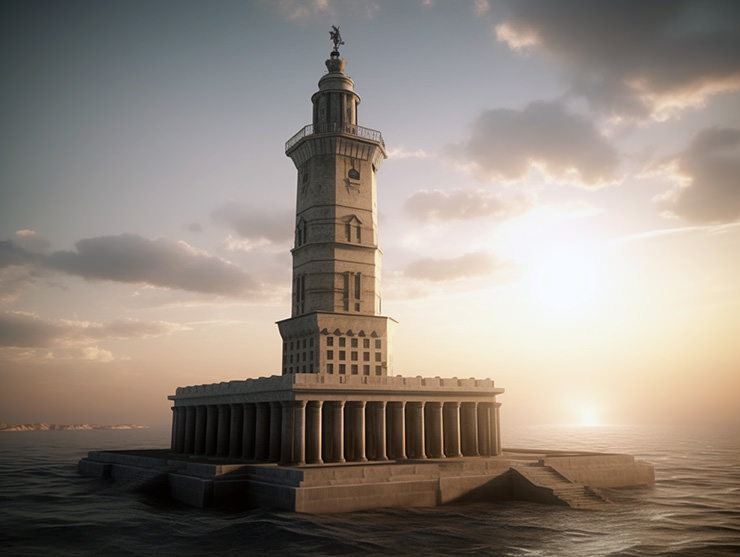
This technological marvel appeared on the Seven Wonders of the Ancient World timeline in 280 BC. The engineering design by its supposed architect Sostratus of Cnidus (they say, a good friend of Egypt’s ruling pharaoh Ptolemy II Philadelphus) became the blueprint for all future lighthouses.
More than a 100-meter-tall structure had a square base, an octagonal middle, and a circular top. It featured a mirror that would reflect sunlight during the day and a firelight to guide sailors at night.
The Lighthouse of Alexandria also doubled as a convenient lookout point, both for tourists and security guards waiting to spot enemy ships.
The pharos from Pharos survived as one of the world’s tallest buildings during its lifetime, which eventually came to an end in the Middle Ages, with earthquakes transforming it into rubble.
The final strike was the trembler of 1480, after which the lighthouse stones were used as a building material for the Citadel of Qaitbay, the defensive fortress standing at its place today.
Can you visit the 7 Wonders of the Ancient World?
Are you feeling adventurous and want to see the great Wonders of the Ancient World? Well, you’re in luck as, even if their glory has mostly passed, there are still things to see.
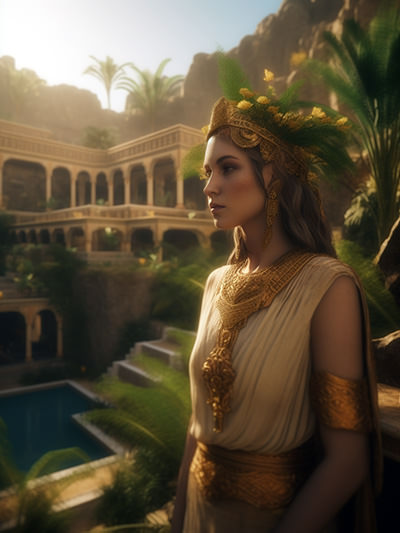
The only place where you would really need a wild imagination is the Hanging Gardens of Babylon. There is no conclusive evidence that would point to their location, or existence for that matter. Some scholars even believe that the legend refers to the garden built in the Assyrian city of Nineveh on the River Tigris, near modern-day Mosul. While you can visit the ruins of Babylon or Nineveh, you won’t find any traces of the gardens.
But for the rest of the original 7 wonders of the world, you’ll need to book flights to the countries of Egypt, Turkey, and Greece. Let’s dive in, sometimes literally!
Two best friends from Texas decided to explore the world wonders at the age of 81. Meet TikTok Traveling Grannies!
Wonders of the World in Egypt
The Great Pyramid of Giza in Egypt, the only wonder of the ancient world that is still standing tall and proud, is easily accessible. It is a part of the complex that includes two other pyramids, the Sphinx, and several other temples and tombs. Here’s a well-rated tour from Cairo or Giza that includes a stop at the Step Pyramid of Saqqara and the ruins of Memphis.
On the site where the Lighthouse of Alexandria once stood, now you can visit the medieval fortress of Qaitbay, which was built over and out of the world wonder’s remains. You can also see some of the pharos debris under the water, on a scuba diving tour that includes the visit to the sunken monuments of the ancient Cleopatra city.
Wonders of the World in Turkey
If you want to see what remained of the Temple of Artemis at Ephesus, that would be literally – one column. You can find it at the archeological site of Ephesus which you can visit as a part of a full-day tour from Izmir, including the stops at the House of the Virgin Mary and the picturesque village of Sirince.
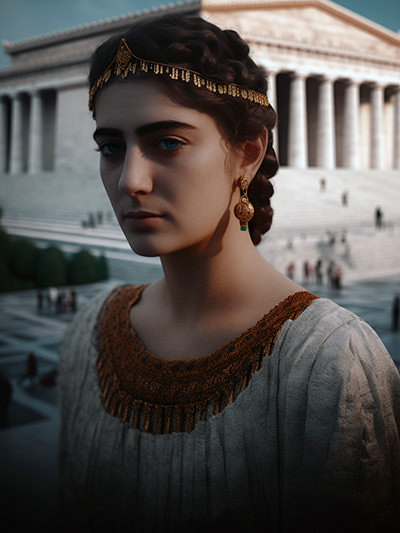
To witness some of the Mausoleum of Halicarnassus, you don’t have to leave London. Room 21 in the British Museum displays fragments of the four-horse chariot that crowned the tomb’s roof, as well as some other statues. Visit the museum on a private exclusive tour.
For a more immersive experience, head to Bodrum, and see the remains of the mausoleum’s foundations and walls on-site. You can join this private Bodrum tour that also includes sightseeing at the Roman Amphitheater and other major landmarks.
If you want an even deeper cultural insight, choose the 12-day tour of Turkey that will lead you to both world wonders in the country, but also plenty of other treasures. Think mosques, palaces, and bazaars of Istanbul, Cappadocia‘s underground and hot-air balloon vistas, and the hot springs of Pamukkale!
Wonders of the World in Greece
Greeks have cooked up the whole World Wonder idea, but are their exponents worth exploring?
There are no fragments of the Olympia‘s Statue of Zeus that you could see, but if you want to get to the site of the temple where it stood, as well as see sculptures and artifacts from the ancient Olympic Games, that’s possible. With the help of a virtual reality headset, you can add a trip back in time to your Olympia visit, and get a glimpse of the mighty Zeus after all.
No fragments of the Colossus of Rhodes have been found, but it’s said that some of its metal was incorporated in the fortifications of this largest active medieval town in Europe. You can enter the world of knights and castles on this e-bike tour. Alternatively, hop aboard a romantic dinner cruise and imagine the towering giant from the ships’ perspective.
From coloring books to board games: Play your way through the 7 Wonders of the Ancient World
Learning about the 7 Wonders of the Ancient World is more fun when one plays.For the littlest of players, there's the Wonders of the World coloring book. Watch as their tiny hands bring to life the most iconic landmarks of the planet in colorful crayons. Slightly older kids will enjoy building the legendary monuments with their own hands. For them, the Mapology construction set is the perfect gift. Let them channel their inner architect as they piece together their very own miniature versions of the wonders. Plus, the 3D puzzle comes with a booklet filled with fascinating facts to learn. If you're looking to reward your children with some screen time that is fun but also educational, introduce them to the 7 Wonders of the Ancient World through Nintendo's namesake game. With the guidance of a wise history professor, they'll be bragging with new knowledge in no time. Kids that prefer to do their own research, could love Lynn Curlee's picture book. The author explores the desire of cultures to leave a permanent mark on Earth with some smart illustrations, including the one focusing on the ratio between the size of the Giza pyramid and – Napoleon. Parents of teenagers should opt for the 7 Wonders of the Ancient World board game. Your adolescents will put their strategic thinking skills to the test while growing their civilization in the award-winning game '7 Wonders'.
7 Wonders of the Ancient World – Conclusion
In a world where skyscrapers are built taller than our egos and technological wonders make us question reality, it’s easy to overlook the marvels of the past. But if we would put the wonders of the ancient world into a realistic perspective, these cutting-edge achievements of engineering in today’s terms would more relate to the trip to the Moon or Mars, than to yet another Burj Khalifa.
Remember that feeling you had when Elon Musk launched a car into space? I believe that combination of awe and disbelief could be comparable to what ancient people must have felt when they were witnessing the ancient Hanging Gardens of Babylon in the desert, or an enchanting white Zeus dressed in gold. Ancient world wonders were one-of-a-kind showstoppers, those that a person has to see to believe.
Seven Wonders of the Ancient World were ambitious masterpieces that left a significant trace in human history
The OG wonders took decades to build but left people speechless for centuries to come. Like some silent influencers of their time, they were fueling people’s interest in traveling and exploring the world. Sure, most of these world wonders were eventually swallowed by the earth, fire, and human greed, but while they lasted, they were a source of amazement and inspiration.
From the majestic pyramids of Giza to the massive Colossus of Rhodes, each wonder was an ambitious masterpiece that left a significant trace in human history. Champions of the wonderworld were expressively documenting the creativity and determination of our civilizations, making their architects famous and rulers proud, while shrinking the definition of impossible.
Nowadays, we wonder how artificial intelligence works at all, while it’s possibly producing a similar effect of mystery like ancient wonders did. Our ancestors are certainly not speaking through the AI images, but as these extraordinary sites flourished in the era before hashtags became a thing, maybe my Midjourney creations can help diminish the FOMO effect.
We will never be able to truly go back in time, but the mere fact that some of these magnificent ajooba landmarks continued living in our collective memory even long after they were gone, shows that our shared human identity still matters.
Did you like reading about the original 7 Wonders of the World?
Pin it for later!

Disclosure: This post may contain affiliate links, meaning if you click on them and make a purchase, Pipeaway may make a small commission, at no additional cost to you. Thank you for supporting our work!

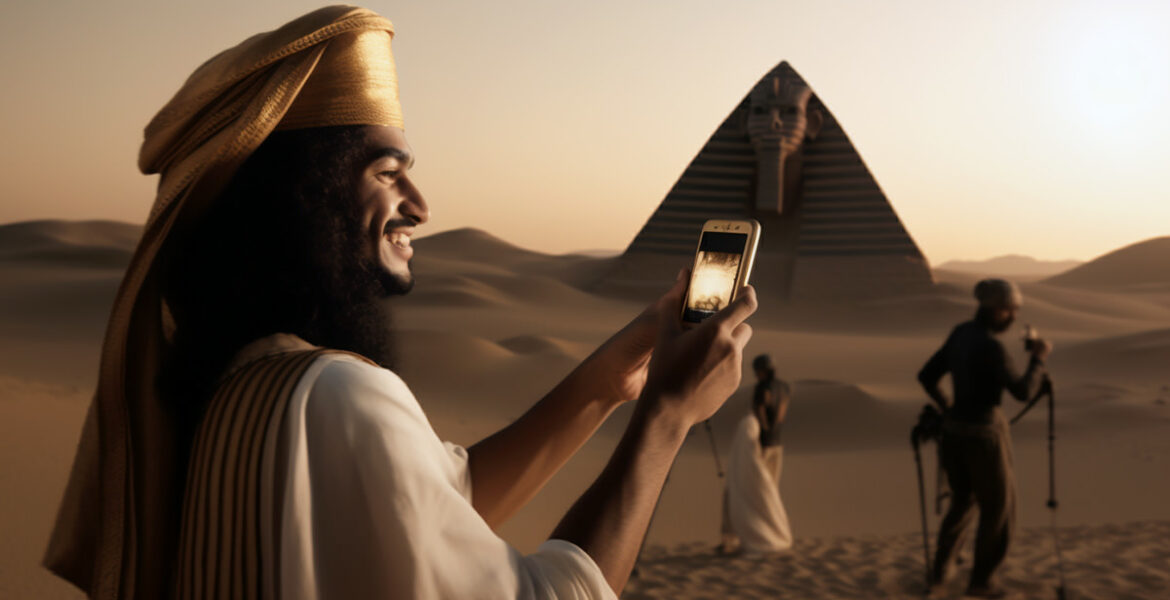
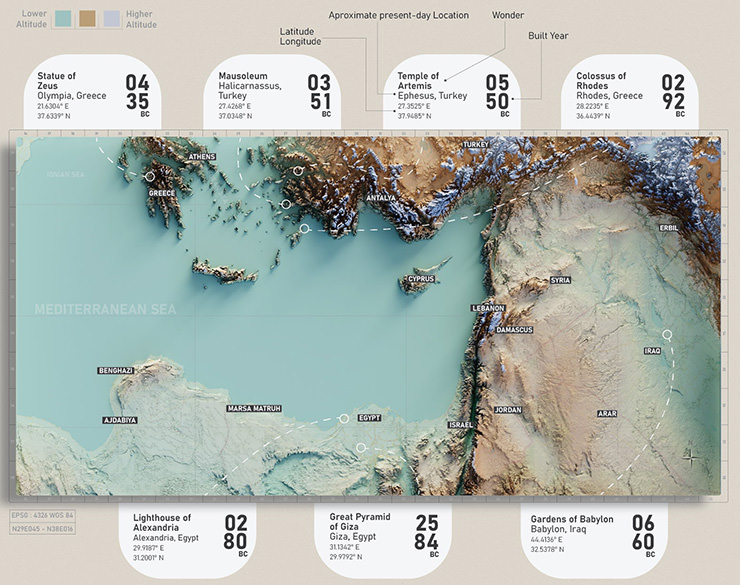


I remember doing a project in middle school on the 7 Wonders of the Ancient World (we had to make a website, and look at me now making a living with a blog!). I love these AI recreations on the wonders, I definitely needed that for my middle school website!
Oh, that’s great to hear, Paige! It’s amazing how those middle school projects can shape our future paths!
I’m thrilled that these AI recreations of the 7 Wonders of the Ancient World resonate with you. It’s fantastic to see how technology has advanced and now offers even more creative ways to explore and showcase these wonders.
But I see that old technologies worked as fine. It’s inspiring to see how your passion for sharing stories and experiences has turned into a fulfilling career.
I wish you continued success with your blog. Keep shining and inspiring others with your unique voice!
Love this approach to using AI as inspiration for travellers to book their next trip! I’m thinking Egypt needs to be bumped up on my list after reading this 😉
Thank you for sharing your thoughts, Megan!
It’s wonderful to hear that this article has sparked your interest in exploring Egypt.
Egypt truly offers a mesmerizing blend of history and culture. From the iconic pyramids of Giza to the fascinating Nile River, there’s no shortage of awe-inspiring sights to discover. It’s great to know that even AI recreations of the ancient wonders can pique people’s curiosity.
Happy travels, and may your journey to Egypt be filled with incredible discoveries!
Thanks for clarifying all this! I always have to look it up since I get them all confused. I was able to see what was once the Artemis at Ephesus. Sad that there is not much left of it.
Hi Michelle!
I’m glad the article could provide some clarity for you. It’s understandable how the wonders of the ancient world can sometimes get mixed up or confused.
While it may be disheartening that only a single column of the Temple of Artemis at Ephesus stands today, it still serves as a powerful reminder of the grandeur and significance of this once magnificent structure.
Although time has taken its toll on many of these ancient wonders, their historical and cultural importance continues to captivate.
Thank you for sharing your thoughts!
Great article! So clever to use AI, especially for the images! I really enjoyed my virtual tour of the ancient seven wonders.
Thank you, Tami!
I’m thrilled to hear that you enjoyed your virtual tour of the ancient wonders.
The power of AI is amazing, and I’m glad you think it added an extra touch of cleverness to the article.
Who says you can’t time-travel from the comfort of your own home, right?
Keep exploring and discovering new wonders, both ancient and modern!